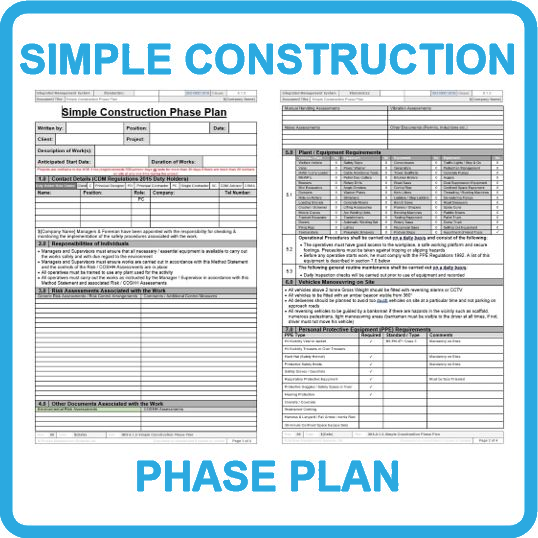Transform your building project’s safety standards with this comprehensive construction phase plan example that industry experts swear by.
Understanding Construction Phase Plans: A Critical Foundation for Project Safety
Construction phase plans are essential documents that form the backbone of project safety management in the UK construction industry. According to recent data from the Health and Safety Executive (HSE), proper implementation of construction phase plans has led to a 23% reduction in workplace accidents across construction sites nationwide. These plans are legally required under the Construction (Design and Management) Regulations 2015 (CDM 2015) and serve as a comprehensive roadmap for managing health and safety throughout the construction process. The plan must be tailored to specific project requirements while ensuring compliance with current regulations and industry best practices.
Key Components of a Construction Phase Plan
- Detailed project description and scope
- Management team structure and responsibilities
- Risk assessments and control measures
- Site rules and emergency procedures
- Health and safety arrangements
- Environmental considerations
Essential Elements of an Effective Construction Phase Plan
A robust construction phase plan begins with a thorough project description that outlines the scope, timeline, and key stakeholders involved. The management team structure should clearly define roles and responsibilities, with particular emphasis on the principal contractor’s duties. Recent industry studies show that projects with well-documented management structures experience 40% fewer safety incidents compared to those with poorly defined hierarchies. Health and safety procedures must be comprehensive yet practical, incorporating site-specific requirements and regulatory compliance measures.
Creating Your Construction Phase Plan: A Step-by-Step Approach
The development of an effective construction phase plan requires a systematic approach, beginning with a thorough initial assessment of the project scope and associated risks. Recent statistics indicate that 78% of successful construction projects attribute their safety record to comprehensive planning during the pre-construction phase. Start by gathering all relevant project information, including architectural drawings, structural calculations, and site surveys. This foundation enables you to create a plan that addresses all potential safety concerns while maintaining project efficiency.
Key Steps in Plan Development
- Conduct initial site assessment and risk evaluation
- Document management arrangements and responsibilities
- Establish control measures for identified risks
- Develop emergency response procedures
- Create communication protocols
- Set up monitoring and review systems
Risk Management and Control Measures
Effective risk management forms the cornerstone of any construction phase plan. According to HSE data, 67% of construction accidents could have been prevented through proper risk assessment and control measures. Begin by identifying potential hazards through systematic site surveys and task analysis. Consider both immediate and long-term risks, including structural stability, working at height, excavation safety, and exposure to hazardous substances. Implement a hierarchy of control measures, prioritising risk elimination over mitigation where possible.
Health and Safety File Management
The health and safety file is a crucial component of your construction phase plan, serving as a living document throughout the project lifecycle. Recent industry research shows that projects with well-maintained health and safety files experience 45% fewer regulatory compliance issues. Ensure your file is easily accessible to all relevant parties while maintaining secure storage of sensitive information. The file should be regularly updated to reflect any changes in project scope, personnel, or safety requirements.
Best Practices for Small-Scale Projects
- Use simplified templates appropriate for project scale
- Focus on essential safety considerations
- Implement CITB guidance for small works
- Maintain clear documentation
- Ensure regular review and updates
- Establish clear communication channels
Ensuring Compliance and Success
Maintaining compliance requires ongoing vigilance and regular updates to your construction phase plan. Studies indicate that projects with quarterly safety reviews are 35% more likely to complete without major incidents. Establish a regular review schedule, incorporating feedback from site personnel and updating procedures as needed. Ensure all team members receive appropriate training and understand their roles in maintaining safety standards.
Expert Tips for Implementation
Successfully implementing your construction phase plan requires practical application of industry best practices. Recent surveys show that construction firms using digital tools for plan management report 50% better compliance rates than those relying on paper-based systems. Leverage technology for real-time monitoring and reporting, while maintaining clear communication channels across all project stakeholders.
Implementation Checklist
- Regular plan reviews and updates
- Comprehensive staff training programmes
- Clear communication protocols
- Digital tool integration
- Regular safety audits
- Continuous improvement processes
Conclusion: Maximising Safety Through Effective Planning
A well-crafted construction phase plan is essential for project success and safety compliance. By following this comprehensive guide and implementing the suggested measures, you can create a robust safety framework for your construction project. Remember that the plan should be a living document, regularly reviewed and updated to reflect changing project conditions and requirements. For additional support, consult the HSE website or seek guidance from industry professionals.
FAQ
What is a phased plan?
As the term suggests, “phased implementation” is the project planning strategy where anything new, such as a software solution, is rolled out in stages rather than all at once. The decision to purchase new software or a new system for your organization is significant.
What does phased construction mean?
Phased construction is where a project is broken down into smaller projects, and phases are carried out over months or even years. It is a preferred approach to a project where there could be financial restrictions, a risk to income or high levels of complexity.
What is the purpose of a phase plan?
The purpose of phase planning in curriculum implementation is to guide learners through a specific phase for a particular subject. It helps ensure that the curriculum is effectively delivered and that students progress through the different phases of learning in a systematic and organized manner.
Sources
[1] https://www.goconstruct.org/educational-resources/learn-about-construction/construction-phase-plan
[2] https://www.safecontractor.com/wp-content/uploads/Guidance-Note-43-Construction-Phase-Plan-Guidance-Note-December-2016.pdf
[3] https://www.citb.co.uk/media/ocsgdlyy/construction-phase-plan-example.pdf


Leave a Reply